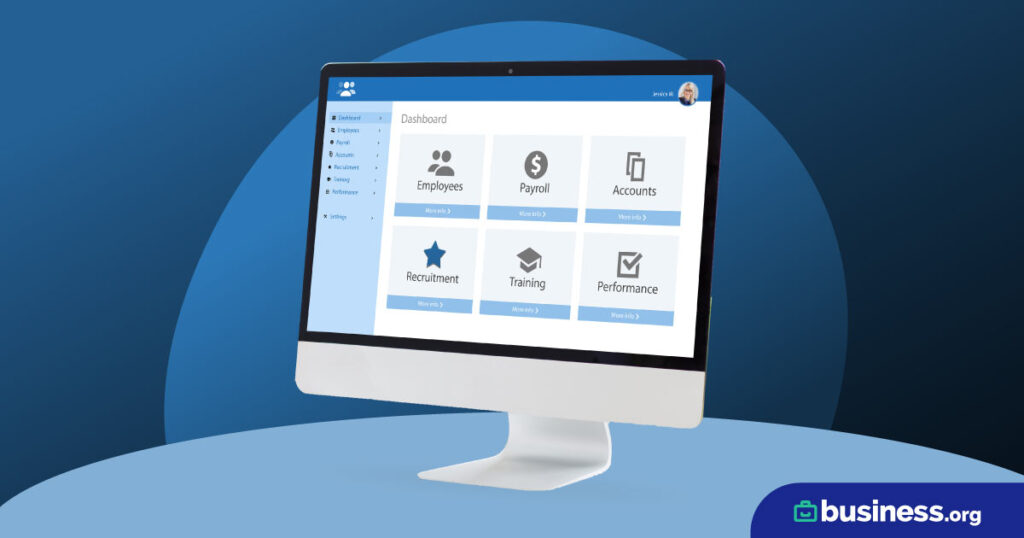We are committed to sharing unbiased reviews. Some of the links on our site are from our partners who compensate us. Read our editorial guidelines and advertising disclosure.
What Is Payroll?
Paying your employees should be simple, right? If your business has two or more employees, you already know the answer to that.
While the term “payroll” typically refers to employers paying their employees, the process itself is a lot more complicated than cutting a check. To run payroll, you need to record your employees’ hours worked for the pay period, calculate the amount of money they earned at their salary or hourly wage, withhold deductions like payroll taxes, and, finally, pay your employees.
If you feel overwhelmed just reading that, we get it. Payroll is stressful. Here’s the good news, though: Whether you’re doing payroll for the first time or modifying how you currently process payroll, we have the scoop on how payroll works, why you need a process, and how you can make payroll as easy as possible.
By signing up I agree to the Terms of Use and Privacy Policy.
What does payroll mean?
Payroll is the process of paying your employees for their time and work. You’ll often hear this process referred to as “running payroll” or “processing payroll.”
However, paying your employees is more than tallying your employees’ hours worked and cutting them a check. Instead, running payroll usually requires an employer to perform each of the following tasks every single pay period:
- Calculate the amount of money an employee earned over the course of the pay period, aka their gross pay.
- Deduct income tax, FICA taxes (the collective term for the Medicare and Social Security tax), and any state and local taxes from the employee’s paycheck.
- Make any other paycheck deductions, such as wage garnishments, health care premiums, 401(k) retirement contributions, and more.
- Calculate the employee’s net pay, or the amount the employee takes home after the correct deductions have been made.
- Pay the employee on time and in the right amount using payment methods like cash, check, payroll debit cards, or direct deposit.
- Keep an accurate record of employee wages, including their gross and net pay, that the employee can access via their pay stub.
Depending on your business, you might also need to calculate overtime, pay bonuses (and withhold bonus taxes correctly), and adjust pay to account for tips.
Employers must also remit payroll taxes to the federal government on a quarterly basis and file end-of-year business taxes. (End-of-year taxes are due in either March or April depending on your business’ corporate structure.) Employers are also required to send end-of-year tax forms to both their employees and the IRS.
What are payroll deductions?
Payroll deductions can be the most confusing part of running payroll, especially for first-time business owners. Even though we touched on deductions above, let’s go through them in a bit more detail.
A payroll deduction is any amount of money an employer is required to deduct from their employees’ wages. These deductions are the difference between an employee’s gross pay (their total compensation) and their net pay (the amount of money they take home).
The most common deductions include the following:
- Federal income tax
- State income tax, if any
- Local income tax, if any
- FICA tax (mandatory Medicare tax and Social Security tax contributions)
- Employee benefit deductions, such as insurance premiums through a company plan
- Retirement contributions to an IRA or 401(k)
- Wage garnishments for creditors, child support, or spousal support
- Other voluntary employee contributions, such as charitable donations
Employers are required by law to withhold payroll taxes correctly and remit them to the appropriate tax authority, specifically the Internal Revenue Service (IRS) and any state and local tax authorities.
To withhold the right amount of taxes from your employees’ gross wages, you’ll collect their tax deduction information using IRS Form W-4. Every employee must submit this form as soon as they’re hired, and it’s your responsibility as the employer to ensure your employees do so.
Do you work with freelancers or contractors rather than W-2 office employees? You still need to process payroll, but you don’t have to deduct and remit contractors’ payroll taxes. Self-employed freelancers file taxes on their own, not through their employer.
At the end of the year, you’ll mail your employees IRS Form W-2, which lists the employees’ gross wages and tax contributions. You’re also required to send copies of your employees’ W-2s to the IRS.
If you have any freelancers on your company’s payroll, you’ll mail them IRS Form 1099-NEC at the end of the year. This form simply lists your freelancer’s compensation so they can file self-employment taxes on their own. Just like Form W-2, you’ll also send copies of Form 1099-NEC to the IRS.
Employer contributions to payroll taxes
Along with withholding employees’ payroll taxes, employers must contribute their own funds to some payroll taxes:
- Employers must match their employees’ FICA tax You remit your FICA tax contribution to the IRS with your employees’ contributions every quarter.
- Employers also pay unemployment taxes based on the Federal Unemployment Tax Act (FUTA tax). Employees do not contribute to FUTA taxes — this is an employer-only tax contribution that you make based on the number of people you hire.
Keep in mind that you can usually write off both your FICA tax contributions and FUTA tax contributions to lower your taxable income at the end of the tax year. An accountant or tax advisor can tell you more about how to make the most of your tax write-offs to ensure you get the best possible tax return.
What are the most common methods of payroll management?
Most small-business owners choose one of three ways to run payroll: by hand with a payroll calculator and payroll template, with payroll software, or through an accountant or human resources department.
Payroll templates
If you employ one to five workers and have exceptional record-keeping skills, you might be able to run payroll yourself (for free!) with a spreadsheet-based payroll template.
You can use the IRS’ tax tables to calculate the right amount of tax withholding, but why bother when you could simply use a paycheck calculator to crunch the numbers instead? Just check, double-check, and triple-check the data you enter before running the calculation—any errors you introduce can cause major problems for your employee come tax time.
And since it’s your job—not your employee’s job—to deduct taxes correctly, you’ll be in legal hot water with the IRS if you make a mistake.
Payroll software
Payroll software is far and away the easiest way for most business owners to run payroll. With self-service payroll software like Patriot Payroll or SurePayroll, you input your employees’ payroll information and the software calculates the right net paycheck amount. You remit taxes to the IRS on your own, but the payroll software generates pre-filled tax forms and syncs with your accounting software to keep accurate financial records.
Full-service payroll software like Gusto or QuickBooks Payroll usually costs a bit more, but the software deposits employees’ checks for you and remits taxes directly to the IRS on your behalf.
Paid payroll software can cost as little as $17 a month, but if you’re worried about costs, you can also take advantage of free payroll software like Payroll4Free.
If you employ a nanny, gardener, in-home nurse, or any other household employee, the IRS considers you a business owner. You’re required to apply for an employer identification number (EIN) and withhold your employee’s payroll taxes. Nanny payroll software can help you correctly calculate your employee’s paycheck and taxes.
Accountants and HR
Bigger companies and small-business owners who prefer expert help should consider outsourcing payroll to an accountant or bookkeeper. Employing another person to run payroll is the most expensive payroll method, but it also saves you the most time and reduces the possibility of payroll errors. For big companies, the HR and accounting departments both have a hand in payroll. (Human resources usually deals with issues like overtime pay, salary, benefits, sick leave, and paid time off, while accounting departments juggle finances.)
While you can find payroll-specific software, you can also find all-in-one payroll, accounting, and HR software. Providers like Gusto usually offer basic HR services like health insurance options and other employee benefits. Software companies like Paychex and ADP lean more heavily into the HR aspect of payroll and offer multiple plans so you can scale up HR support as your business grows.
Compare your payroll solutions
Best payroll management practices
Satisfying your employees (and the IRS) doesn’t just mean running payroll. It also means running payroll correctly, efficiently, and on time. These guidelines will help ensure you’re doing right by your employees while minimizing wasted time and money.
1. File financial data on time.
We can’t stress this enough: Pay your employees on time, every time and submit the right information and withholding amount to the local, state, and federal governments on time, every time. Timely paychecks keep your employees happy and help you stay professional. Timely tax filings help you avoid an audit by the federal government.
Of course, the small-business world is full of financial ups and downs, so you might not always have money in the bank to pay employees every time. If that’s the case, you can find solutions like payroll loans.
Like other types of instant financing, payroll funding can cost you over time, but not paying your employees is a mistake most businesses can’t afford to make. Carefully weigh your cash flow expectations and employee situation as you decide whether payroll funding is a good choice for you.
2. Keep accurate, detailed payroll records.
Because a crucial part of payroll is peace of mind for you, your employees, and the government, keeping accurate payroll records, including W-4s and pay stub records, should give you confidence in your payroll methods.
Having a solid paper trail (better yet, a digital paper trail, if you want to save time, money, and energy— and we know you do) can resolve employee disputes over payments and prove you’re in compliance with all federal regulations and tax codes.
3. Digitize payments and financial records.
Like we said, digital records save energy, paper, and expense. They also reduce your risk of losing crucial data if your office floods or a fire breaks out. Meanwhile, directly depositing money into your employees’ bank accounts gives them immediate access to it and reduces the risk of losing money from misplaced checks.
4. Double- and triple-check employee data and classification.
If you finish the fiscal year and realize you classified a full-time employee as a part-time worker or paid a freelancer the same way you paid a temp worker, you’ll be in trouble with the IRS. Periodically check your employees’ classification and withholdings so you can fix errors immediately—these are the types of mistakes most small businesses may not survive.
Don’t forget that employees might change their withholding amounts throughout the year—especially if a major life event occurs, like the addition of a new dependent. Automated payroll software keeps you on top of financial changes so you can help employees transition seamlessly into a new financial situation.
5. Set clear expectations.
We’ve talked a lot about the employer’s responsibility to their employees, but your employees also have responsibilities. For instance, they need to submit their W-4 forms in a timely fashion and to the right department. If they want direct deposit, they need to give you correct bank information. And they’re in charge of setting their tax withholding percentage—not you.
Most of these financial responsibilities seem obvious, but make them clear by putting them in an employee handbook. And yes, you should consider creating an employee handbook, even if you have only three or four employees. Creating one isn’t legally required, but doing so can keep you out of legal trouble if an employee doesn’t follow through on their financial responsibilities.
Employees also need clear expectations about when they’ll be paid, how much will be deducted from their paychecks for benefits like insurance, and whether they can work overtime or not. Payroll should be as transparent as possible. Make sure each employee knows how to submit hours and what to do if they spot a problem with their pay. Again, an employee handbook is an excellent place to store this information.
6. Make time to audit your payroll process.
As your business grows, your needs shift, including your payroll needs. Is your company big enough to outsource payroll services? Do you need a full-time accountant? Is it time to upgrade your payroll software?
Assessing your payroll system’s efficiency might seem like an unnecessary chore that just takes time away from your day-to-day operations. But the half day it takes to audit the system and find pain points or weaknesses will pay off later when you have a payroll solution that perfectly suits your business.

With unlimited payroll runs and automatic tax filing, Gusto helps small-business owners worry less about payroll and put more time into growing their business.
- Get automatic payroll tax filing, including end-of-year tax forms
- Manage workers compensation insurance
- Track paid time off, sick leave, and holiday pay
The takeaway
Payroll is complicated. It can be stressful. But it’s totally, completely manageable—even the payroll taxes. Whether you opt for software over an accounting department or hire a CPA instead of outsourcing, you can run payroll efficiently, effectively, and to everyone’s satisfaction—even when it comes to the IRS.
Check out our review of the year’s best accounting software for small businesses to pair the perfect bookkeeping solution with your payroll management system.
Related reading
Disclaimer
At Business.org, our research is meant to offer general product and service recommendations. We don't guarantee that our suggestions will work best for each individual or business, so consider your unique needs when choosing products and services.




